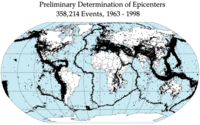
Photo from wikipedia
Various studies report on temporal changes of seismic velocities in the crust and attempt to relate the observations to changes of stress and material properties around faults. Although there are… Click to show full abstract
Various studies report on temporal changes of seismic velocities in the crust and attempt to relate the observations to changes of stress and material properties around faults. Although there are growing numbers of observations on coseismic velocity reductions, generally there is a lack of detailed observations of the healing phases. Here we report on a pronounced coseismic reduction of velocities around two locked sections (asperities) of the Longmenshan fault with a large slip during the 2008 Mw 7.9 Wenchuan earthquake and subsequent healing of the velocities. The healing phase accelerated significantly at the southern asperity right after the nearby 2013 Mw 6.6 Lushan earthquake. The results were obtained by joint inversions of travel time data at four different periods across the Wenchuan and Lushan earthquakes. The rapid acceleration of healing in response to the Lushan earthquake provides unique evidence for the high sensitivity of seismic velocities to stress changes. We suggest that stress redistribution plays an important role in rebuilding fault strength.After a fault ruptures, the recovery of its strength may be accelerated by earthquakes that redistribute stress, according to an analysis of temporal variation in crustal seismic velocity on the Longmenshan fault in China.
Journal Title: Nature Geoscience
Year Published: 2019
Link to full text (if available)
Share on Social Media: Sign Up to like & get
recommendations!